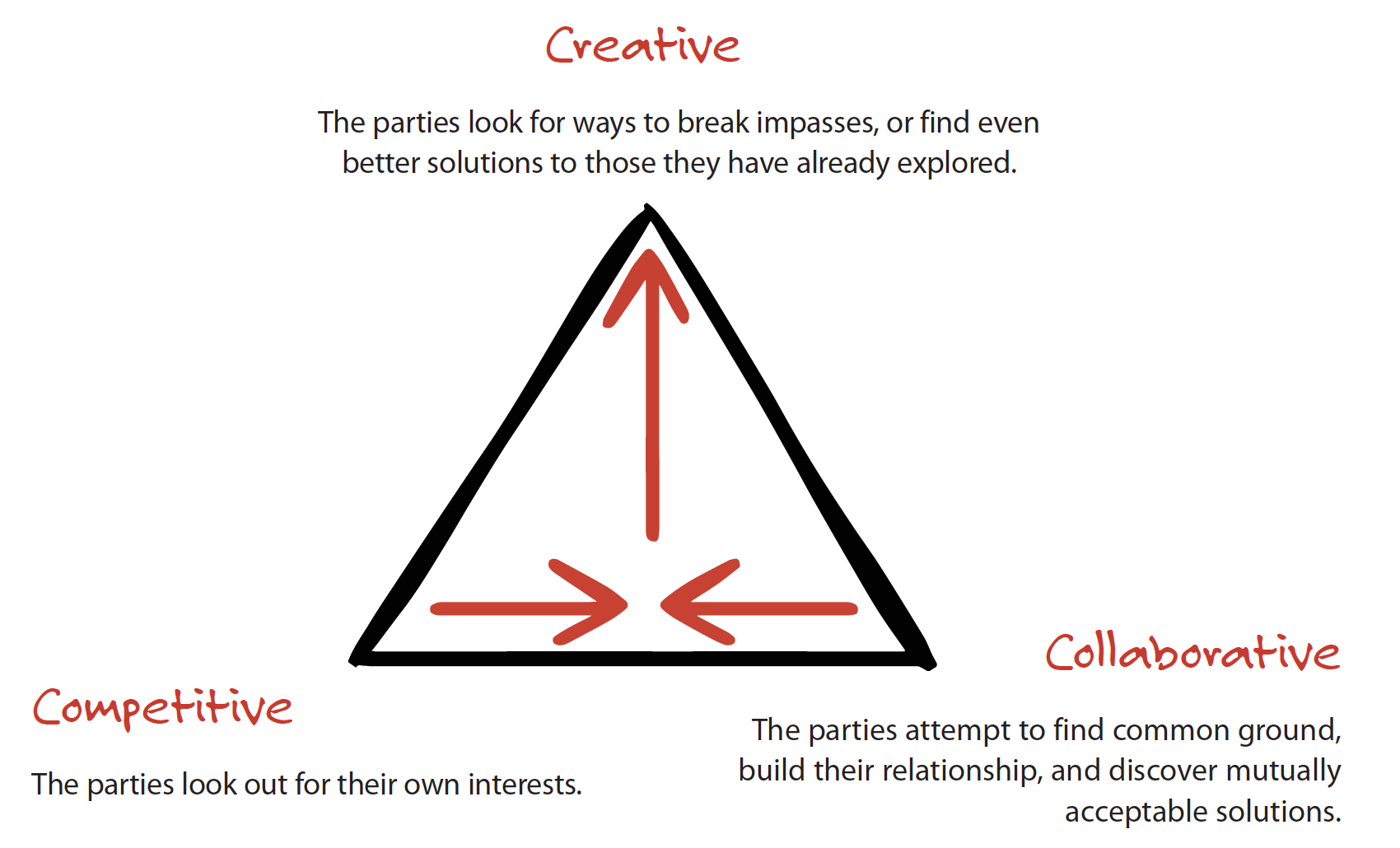What does it take to succeed in negotiations? Does it mean getting the best price? Securing the best possible deal?
Whether it’s a sale with a new client or a procurement deal with a long-standing partner, trust in negotiations is paramount. A skilled negotiator will leverage the power of trust to steer the outcome toward a mutually beneficial result while laying the foundation for fruitful negotiations in the long run.
While many perceive negotiation as a high-stakes game where one wrong move could spell disaster, in truth, negotiation is less about manipulative tactics and more about human interaction — about building trust.
Negotiation is as much an art as it is a skill. To master it, you need a comprehensive framework of strategies, tools, and behaviors — like the training you’ll receive through RED BEAR.
Trust is the invisible currency that can make or break a deal. But it’s more than about truth-telling or keeping promises; it's about establishing a mutual understanding and respect between parties. One essential element of building trust is gratitude — and that’s what we’ll explore today.
Here at RED BEAR, our mission is simple: transform your team into world-class negotiators. Our training gets results. In fact, for every dollar invested into our workshops, our clients receive, on average, $54 back.
In the spirit of gratitude, to celebrate our 10th anniversary, throughout November, we’re pulling back our prices to our original pricing 10 years ago. This celebration won’t last forever, so be sure to explore your training options today.
Unpacking the Three Dimensions of Negotiation
Before we dive into the power of trust in negotiations and how gratitude integrates into RED BEAR’s negotiation strategies, we need to start with the Three Dimensions of a Negotiation.
Every negotiation has three dimensions:
- Competitive
- Collaborative
- Creative

Each dimension brings a powerful element to negotiations. No one dimension should exist on its own but rather stay in balance with each other to create healthy tension that can help break stubborn impasses.
We’ve explored the power of each dimension in our blog, The 3 Dimensions of Every Sales Negotiation, so be sure to check out that post to dive deeper into this RED BEAR concept.
For now, though, we’ll hone in on the Collaborative Dimension.
It’s also worth noting that this concept extends past sales and influences every type of negotiation — from cross-cultural to procurement.
The Emotional Investment in Collaboration
Collaboration is more than just working well together and agreement on specific terms. It’s about building a relationship rooted in trust, mutual respect, and understanding.
It involves an emotional investment from both parties, who need to feel that their opinions are valued and that the final outcome will benefit them mutually. Trust is the glue that holds this emotional bond together.
Gratitude acts as a powerful tool to build trust.
“Gratitude acts as a powerful tool to build trust.”
When a negotiator expresses genuine gratitude for a partner’s stance, needs, or concessions, they send a clear message: “I value your contribution to this negotiation.”
This can be especially powerful during the concessions stage of a negotiation. A negotiation based on trust and collaboration is more likely to result in fair concessions from both parties.
Gratitude can ease the rigid lines usually drawn around 'gives' and 'takes,' thereby creating room for more flexible and favorable terms.
Set the Stage for Trust in Negotiations
First impressions are invaluable. The first interaction, whether it’s a handshake, a greeting, or even a first email, lays the foundation for the rest of the negotiation.
Simple gestures like arriving on time, being well-prepared, and giving your full attention can go a long way in establishing a sense of professionalism and respect. There are also the things not said that make a difference.
Body language often speaks louder than words. Maintain eye contact, keep your arms uncrossed, and lean in slightly to show the other party you're fully engaged. This simple but effective body language sends a strong signal of openness and willingness to collaborate.
Gratitude comes into focus throughout virtually every interaction. It can be as simple as offering thanks for their time or for past discussions. This signals that you don’t see this negotiation as a one-time event but rather as part of an ongoing relationship.
Collaboration and the Negotiation Behaviors
The Five Negotiation Behaviors weave their way into the Three Dimensions of Negotiation. When it comes to collaboration, relationship behaviors come into play:
- Ask Open Questions
- Test and Summarize
- Propose Conditionally
When these behaviors are balanced with the Competitive/Self-Interest behaviors, you can leverage healthy tension to unlock the power of the Creative Dimension — which can lead to breakthroughs. Using gratitude alongside these behaviors, you can start to not only build trust but uncover the other party’s underlying needs, help them feel understood, and, ultimately, generate creative solutions that break impasses.
Approach each negotiation with the goal of developing a relationship and building trust, and you won’t just reach the best outcome for both parties; you’ll strengthen a bond that will offer value for years to come.
Gratitude in Action
Once you’ve set the stage for trust in negotiations, gratitude still stands as an invaluable tool. Negotiations aren't static. In fact, the best negotiators, whether they’re in a tense sales deal or managing multiple procurement partners, understand the dynamics of a shifting discussion.
In any case, a little gratitude goes a long way.
For example, let’s say a sales negotiation becomes difficult. Both parties seem to be at an impasse on price, and no one wants to budge an inch. Here, gratitude may seem like a distant idea. But, a simple “Thank you for bringing that to the table; it’s an important point, and I appreciate your openness” can often move mountains.
It shows that you have an interest in maintaining open communication and an understanding of the other party’s position. Expressing gratitude for the other party’s candor in addressing these matters can diffuse negative tension and foster a collaborative atmosphere.
Here’s another scenario: you’re in the final hours of a procurement negotiation. While both parties have made significant progress on pricing, delivery, and other negotiables, there’s still some work left.
During a long negotiation, it’s easy to get bogged down in the details and forget the big picture. Time is subjective, and in these types of situations, a few hours can feel like a lifetime, which only adds to the frustration. To combat this, employ gratitude. When a significant point is agreed upon, or a challenging obstacle is overcome, take a moment to express gratitude for the progress made.
This can create a shared sense of accomplishment between both parties. This simple gesture of gratitude can help the rest of the discussion feel less like a battle and more like a collaborative effort.
The best part? Gratitude doesn’t cost anything. It requires little to no extra effort, and it can be a powerful way to connect and make an impact.
“Gratitude doesn’t cost anything. It requires little to no extra effort, and it can be a powerful way to connect and make an impact.”
RED BEAR’s Commitment to Gratitude
You should never overlook gratitude. It’s a direct and effective way to build trust in negotiations — especially when paired with the RED BEAR Negotiation methodology.
From finding common ground to breaking stubborn impasses, our training focuses on the tools, skills, and behaviors your team needs to craft profitable, value-based agreements with customers, suppliers, and internal team members.
There’s no better time to start your own negotiation journey. For a limited time this year, we’re celebrating 10 years of RED BEAR with retro pricing. Your team can get the same training utilized by 45% of Fortune 500 companies at a significant discount.
To get started, connect with the RED BEAR team today.
Fill out our contact form and we will be back to you in no later than one business day.



.png?width=960&height=540&name=ultimate-guide-sales-negotiation-training-cta%20(2).png)


